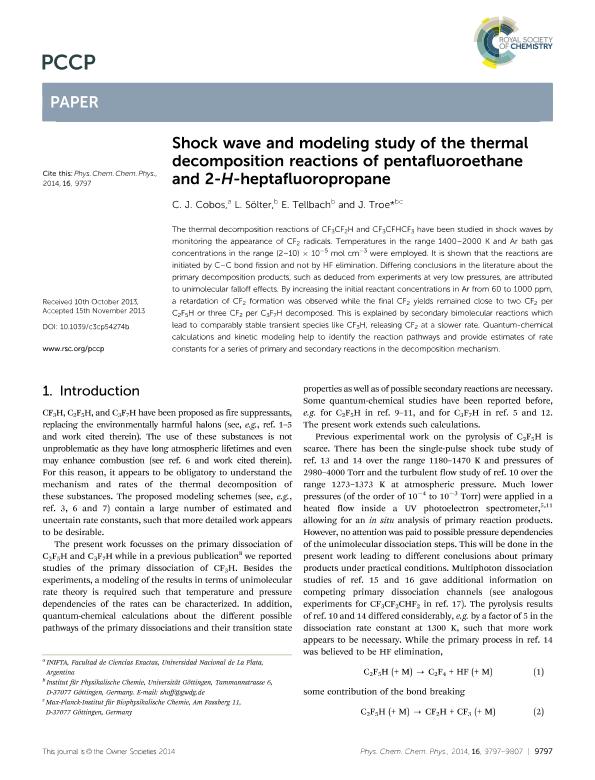Mostrar el registro sencillo del ítem
dc.contributor.author
Cobos, Carlos Jorge

dc.contributor.author
Sölter, L.
dc.contributor.author
Tellbach, E.
dc.contributor.author
Troe, J.
dc.date.available
2016-04-15T14:50:19Z
dc.date.issued
2014-01
dc.identifier.citation
Cobos, Carlos Jorge; Sölter, L.; Tellbach, E.; Troe, J.; Shock wave and modeling study of the thermal decomposition reactions of Pentafluoroethane and 2-H Heptafluoropropane; Royal Society Of Chemistry; Physical Chemistry Chemical Physics; 16; 21; 1-2014; 9797-9807
dc.identifier.issn
1463-9076
dc.identifier.uri
http://hdl.handle.net/11336/5221
dc.description.abstract
The thermal decomposition reactions of CF3CF2H and CF3CFHCF3 have been studied in shock waves by monitoring the appearance of CF2 radicals. Temperatures in the range 1400-2000 K and Ar bath gas concentrations in the range (2-10) × 10(-5) mol cm(-3) were employed. It is shown that the reactions are initiated by C-C bond fission and not by HF elimination. Differing conclusions in the literature about the primary decomposition products, such as deduced from experiments at very low pressures, are attributed to unimolecular falloff effects. By increasing the initial reactant concentrations in Ar from 60 to 1000 ppm, a retardation of CF2 formation was observed while the final CF2 yields remained close to two CF2 per C2F5H or three CF2 per C3F7H decomposed. This is explained by secondary bimolecular reactions which lead to comparably stable transient species like CF3H, releasing CF2 at a slower rate. Quantum-chemical calculations and kinetic modeling help to identify the reaction pathways and provide estimates of rate constants for a series of primary and secondary reactions in the decomposition mechanism.
dc.format
application/pdf
dc.language.iso
eng
dc.publisher
Royal Society Of Chemistry

dc.rights
info:eu-repo/semantics/openAccess
dc.rights.uri
https://creativecommons.org/licenses/by-nc-sa/2.5/ar/
dc.subject
Pentafluoroethane
dc.subject
2-H-Heptafluoropropane
dc.subject.classification
Físico-Química, Ciencia de los Polímeros, Electroquímica

dc.subject.classification
Ciencias Químicas

dc.subject.classification
CIENCIAS NATURALES Y EXACTAS

dc.title
Shock wave and modeling study of the thermal decomposition reactions of Pentafluoroethane and 2-H Heptafluoropropane
dc.type
info:eu-repo/semantics/article
dc.type
info:ar-repo/semantics/artículo
dc.type
info:eu-repo/semantics/publishedVersion
dc.date.updated
2016-05-06 15:52:43.262787-03
dc.journal.volume
16
dc.journal.number
21
dc.journal.pagination
9797-9807
dc.journal.pais
Reino Unido

dc.journal.ciudad
Londres
dc.description.fil
Fil: Cobos, Carlos Jorge. Consejo Nacional de Investigaciones Científicas y Técnicas. Centro Científico Tecnológico la Plata. Instituto de Investigaciones Fisicoquímicas Teóricas y Aplicadas; Argentina. Universidad Nacional de La Plata; Argentina
dc.description.fil
Fil: Sölter, L.. Universitat of Gottingen; Alemania
dc.description.fil
Fil: Tellbach, E.. Universitat of Gottingen; Alemania
dc.description.fil
Fil: Troe, J.. Max-Planck-Institut für Biophysikalische Chemie; Alemania
dc.journal.title
Physical Chemistry Chemical Physics

dc.relation.alternativeid
info:eu-repo/semantics/altIdentifier/url/http://pubs.rsc.org/en/Content/ArticleLanding/2014/CP/C3CP54274B#!divAbstract
dc.relation.alternativeid
info:eu-repo/semantics/altIdentifier/doi/http://dx.doi.org/10.1039/c3cp54274b
Archivos asociados
